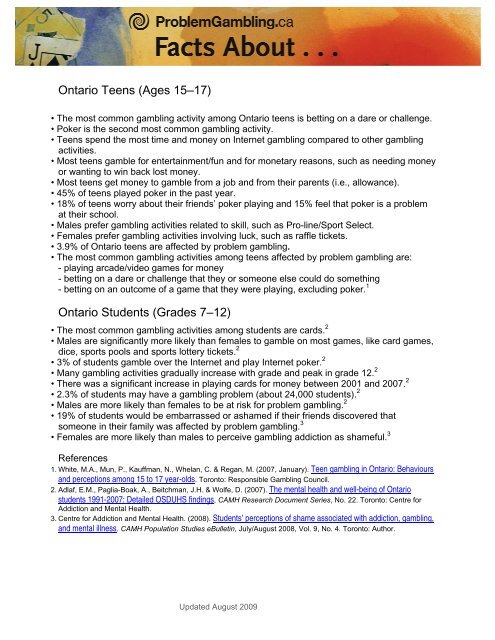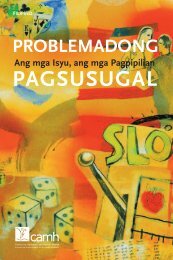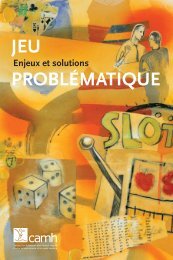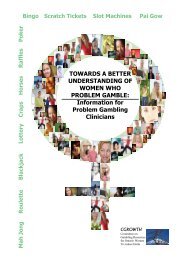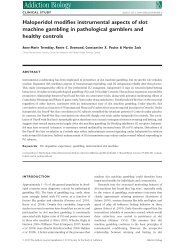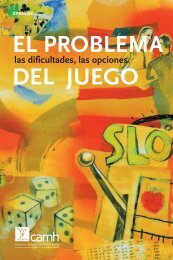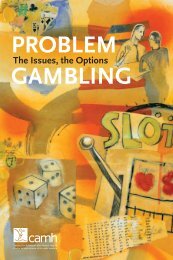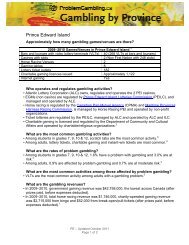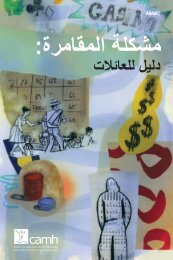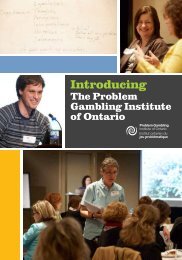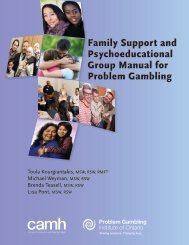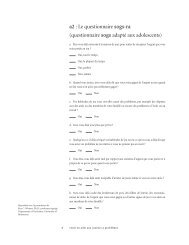Methods:CAMH’s Ontario Student Drug Use and Health Survey(OSDUHS) is an Ontario-wide survey of elementary/middle schoolstudents in grades 7 and 8 and secondary school students in grades9 to 12. The survey has been conducted every two years since 1977with the purpose of monitoring substance use, perceptions aboutsubstance use, mental health, physical health, and risk behavioursamong students. The 2009 survey, which used a stratified (region,school type) two-stage (school, class) cluster design was based on9,112 students in grades 7 to 12 from 47 public and Catholic schoolboards, 181 schools, and 573 classes. Self-administeredquestionnaires, which promote anonymity, were administered bystaff from the Institute for Social Research, York University on aclassroom basis between November 2008 and June 2009. Thestudent participation rate was 65%. The 2009 total samplerepresents about 1,023,900 students in grades 7 to 12. Note thatbeginning in 1999, students in grades 7 through to 12 weresurveyed, whereas only grades 7, 9, and 11 were surveyed in thecycles prior to 1999. All survey estimates were weighted, andvariance and statistical tests were corrected for the samplingdesign.Measures & Terminology:• Physical activity was measured by asking students to indicateon how many of the past 7 days they exercised or playedsports for a total of at least 60 minutes that “increased yourheart rate and made you breathe hard some of the time.”Inactive is defined as reporting no days of physical activity.• Sedentary behaviour (also called “screen time”) is defined aswatching TV and/or on a computer for 7 hours or more perday, on average, during the 7 days before the survey.• Overweight and obesity: exceeding the age-and-sex-specificbody mass index (BMI) cut-off values established for childrenand adolescents and recommended by the InternationalObesity Task Force, based on self-reported height and weight.• The “choking game” is self-asphyxiation or being choked bysomeone else for the purpose of a euphoric feeling (or “ahigh”).• Medical drug use is defined as reporting the use of theprescription drug with a doctor’s prescription at least once inthe past 12 months.• Mental health professional visit is defined as reporting atleast one visit to a doctor, nurse, or counsellor for emotionalor mental health reasons in the past 12 months.• Low self-esteem is defined as responding negatively to atleast 3 out of 6 items adapted from the Rosenberg Self-EsteemScale.• Depressive symptoms is defined as “usually” or “often”experiencing all 4 symptoms on the Center for EpidemiologicStudies Depression subscale (past 7 days time frame).• Elevated psychological distress is measured with the GeneralHealth Questionnaire (GHQ), which is a 12-item screeninginstrument designed to assess current mental health. The itemsassess the recent frequency of experiencing 12 symptoms(e.g., stress, depression, problem making decisions).Psychological distress is defined as experiencing at least 3 ofthe 12 symptoms.• Delinquent behaviour is defined as participating in 3 or moreof 11 behaviours (e.g., theft, vandalism, assault, cartheft/joyriding, drug selling) at least once in the past 12months.• Bullying is defined as “...when one or more people tease, hurtor upset a weaker person on purpose, again and again. It isalso bullying when someone is left out of things on purpose.”Students were asked what was the main way they werebullied, and bullied others, since September. The responseoptions were: (1) was not involved in bullying at school; (2)physical attacks (e.g., beat up, pushed or kicked), (3) verbalattacks (e.g., teased, threatened, spread rumours), and (4) stoleor damaged possessions. The prevalence rates for bullyingvictim and perpetrator are based on these modal questions.• Any gambling activity is defined as reporting gamblingmoney in the past 12 months on 1 or more of the 10 gamblingactivities asked about in the survey.• Multi-gambling activity is defined as gambling money in thepast 12 months on 5 or more of the 10 gambling activities.• <strong>Gambling</strong> problem is measured with a reduced version of theSouth Oaks <strong>Gambling</strong> Screen Revised for Adolescents(SOGS-RA), and is defined as experiencing 2 or more of the 6symptoms in the past 12 months.• Video gaming problem is measured with the Problem VideoGame Playing (PVP) Scale, and is defined as experiencing 5or more of 9 symptoms in the past 12 months.• Region: the survey design divides the province into fourregions: Toronto; Northern Ontario (Parry Sound District,Nipissing District and farther north); Western Ontario (PeelDistrict, Dufferin County and farther west); and EasternOntario (Simcoe County, York County and farther east).• 95% confidence interval (CI) can be crudely interpreted asbeing 95% likely to include the “true” value if every studentin grade 7 to grade 12 in Ontario was surveyed.• Statistically significant difference refers to a differencebetween two percentages that is not likely due to chance. Forexample, a difference found at the p
Ontario Teens (Ages 15–17)• The most common gambling activity among Ontario teens is betting on a dare or challenge.• Poker is the second most common gambling activity.• Teens spend the most time and money on Internet gambling compared to other gamblingactivities.• Most teens gamble for entertainment/fun and for monetary reasons, such as needing moneyor wanting to win back lost money.• Most teens get money to gamble from a job and from their parents (i.e., allowance).• 45% of teens played poker in the past year.• 18% of teens worry about their friends’ poker playing and 15% feel that poker is a problemat their school.• Males prefer gambling activities related to skill, such as Pro-line/Sport Select.• Females prefer gambling activities involving luck, such as raffle tickets.• 3.9% of Ontario teens are affected by problem gambling.• The most common gambling activities among teens affected by problem gambling are:- playing arcade/video games for money- betting on a dare or challenge that they or someone else could do something- betting on an outcome of a game that they were playing, excluding poker. 1Ontario Students (Grades 7–12)• The most common gambling activities among students are cards. 2• Males are significantly more likely than females to gamble on most games, like card games,dice, sports pools and sports lottery tickets. 2• 3% of students gamble over the Internet and play Internet poker. 2• Many gambling activities gradually increase with grade and peak in grade 12. 2• There was a significant increase in playing cards for money between 2001 and 2007. 2• 2.3% of students may have a gambling problem (about 24,000 students). 2• Males are more likely than females to be at risk for problem gambling. 2• 19% of students would be embarrassed or ashamed if their friends discovered thatsomeone in their family was affected by problem gambling. 3• Females are more likely than males to perceive gambling addiction as shameful. 3References1. White, M.A., Mun, P., Kauffman, N., Whelan, C. & Regan, M. (2007, January). Teen gambling in Ontario: Behavioursand perceptions among 15 to 17 year-olds. Toronto: Responsible <strong>Gambling</strong> Council.2. Adlaf, E.M., Paglia-Boak, A., Beitchman, J.H. & Wolfe, D. (2007). The mental health and well-being of Ontariostudents 1991-2007: Detailed OSDUHS findings, CAMH Research Document Series, No. 22. Toronto: Centre forAddiction and Mental Health.3. Centre for Addiction and Mental Health. (2008). Students’ perceptions of shame associated with addiction, gambling,and mental illness. CAMH Population Studies eBulletin, July/August 2008, Vol. 9, No. 4. Toronto: Author.Updated August 2009


